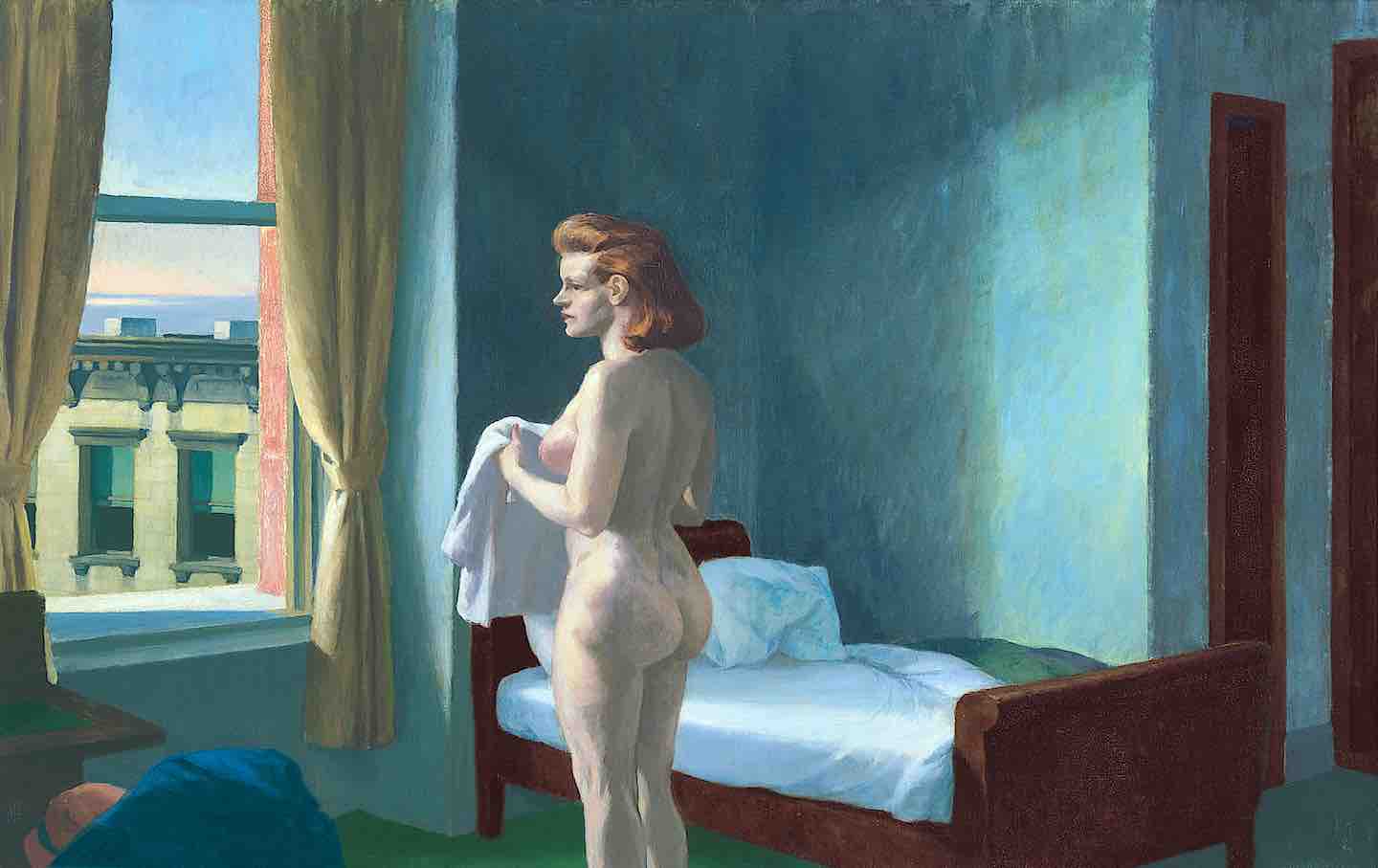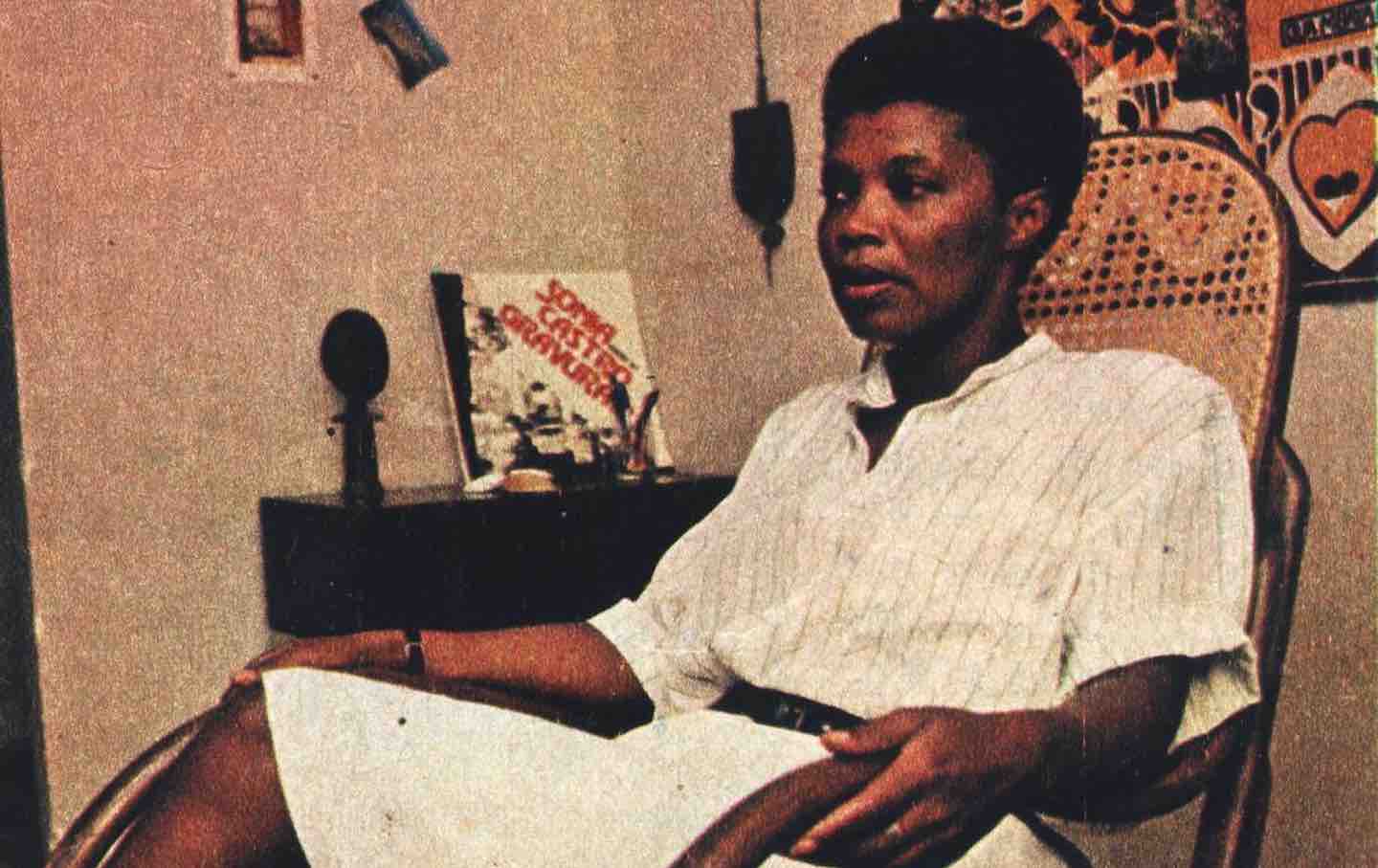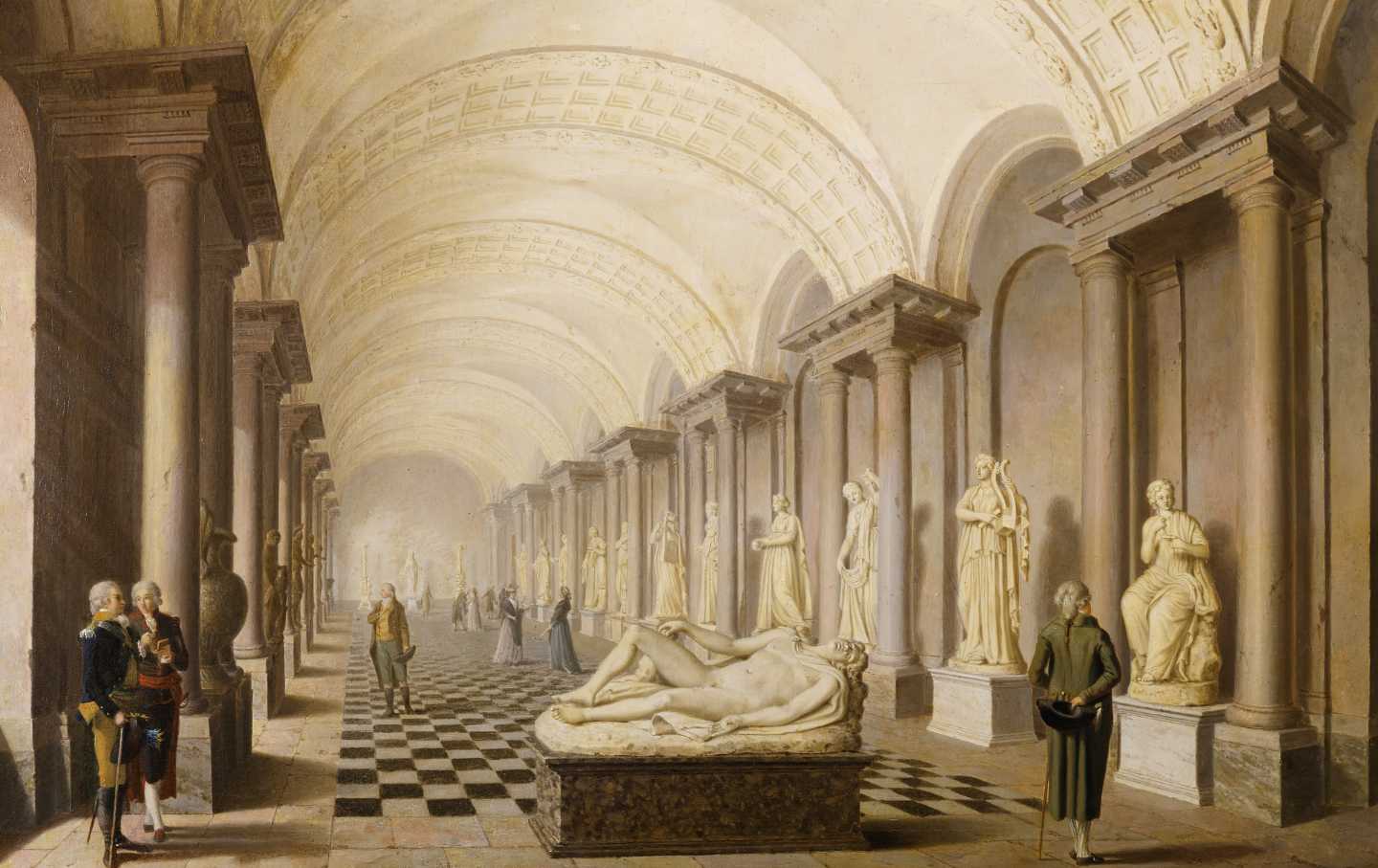Michael Mann’s Need for Speed
The director’s biopic of Enzo Ferrari is a perfect encapsulation of his primary aesthetic interest: the death drive and male melancholy.

Adam Driver in Ferrari.
(Photo by Lorenzo Sisti)Death haunts Ferrari. Michael Mann’s new film confines itself to three months in Modena, Italy, in the summer of 1957, a crucial period in the life of Enzo Ferrari and the automobile company that bears his name. Ferrari (Adam Driver) and his wife, Laura (Penélope Cruz), are at odds following the recent death of their son, Dino, from muscular dystrophy at age 24. Each is alone in their grief: Every morning Enzo brings flowers to his son’s grave and weeps; Laura—grimmer, silent—waits until he leaves, then brings her own. Enzo keeps his mistress Lina (Shailene Woodley) in a house outside of town, where another son—unacknowledged, and as yet undiscovered by Laura—lives too. Meanwhile, the company, of which Laura is part owner, is failing: It is not making enough road cars to support the racing team, while Ferrari’s racers, whose prestige in turn powers the retail business, are themselves under threat from Maserati. The creditors are closing in; Laura is poking around in Enzo’s affairs; his drivers are getting distracted and getting killed; and his son by his mistress wants to know what his last name is. Ferrari pins his hopes on winning the Mille Miglia, a thrilling and, in retrospect, macabre 1,000-mile race through the spectator-thronged roads of Italy that after 1957 would never be run again. This is the make-or-break moment for Ferrari. He must win, or lose everything. On the way to the race, Enzo stops over to see Lina. “How much time do you have?” she asks. Not enough.
Running out of time, the pressing-in of fate, is perhaps the central theme of Michael Mann’s work. Destiny drives his heroes, most of whom are antiheroes; from Thief to Heat to Ali to Miami Vice, these men (they are always men), whether they are cops or criminals, ordinary or famous, find themselves at odds with the social order and blocked from their own deepest desires. In Heat, Mann’s 1995 masterpiece, Robert De Niro’s Neil Macauly, a master thief, explains his catechism: “Don’t let yourself get attached to anything you are not willing to walk out on in 30 seconds flat if you feel the heat around the corner.” Life here is governed by a singularity of purpose so total, so extreme, that purpose itself seems to dissolve into an atmosphere, a fatalism of pure drive beyond meaning. “I do what I do best: I take scores,” Macauly tells LAPD detective Vincent Hanna (Al Pacino), his enemy and his double. “You do what you do best: try to stop guys like me.” Or as he puts it to his new girlfriend (and you can guess how that relationship will turn out), “Time is luck”—a phrase repeated by characters in at least two other Mann movies. In Mann’s universe, purpose is a compulsion, not a choice, and life is what happens in the gap, the 30 seconds before you walk out. Never for a second does a character question his path, and yet all are haunted by the sense that the path leads to ruin—and that everything that matters lies elsewhere. With car racing, Mann has found perhaps the most literal expression of his fundamental theme: Ferrari has set a narrow track for himself to run, and the clock is ticking.
Mann is the greatest director of action sequences in the history of cinema. Films like Heat and Public Enemies (2009) transfigure the shootout into a ballet: pure motion of men and things, an apocalypse of senseless violence at once unyieldingly horrific and almost unbearably beautiful. There is something hyperreal about these sequences, and in fact the famous shootout in Heat has inspired deadly real-life bank robberies as well as Marine Corps weapons-training protocols. And yet the most powerful moments in Mann’s films are not scenes of action but of stillness: the in-between moments of reflection, desire, and sadness, in which the pathos that drives the characters seeps out into the frame and the atmosphere itself seems to resonate with passionate intensity. Thief (1981), Heat, and Miami Vice (2006), despite their macho reputations, are deeply romantic films. Call it the male weepie: For Mann, tragic action takes a backseat to melodramatic languor, and in the brief window before the heat closes in, the march of fate gives way to something else—the fantasy that things could be otherwise; the glimmer of another world.
Enzo Ferrari fits comfortably into this canon of masculine melancholics. A façade of restraint and rigid perfectionism conceals a smoldering emotional intensity; this is the director’s first male character that we have ever seen cry. (Perhaps he’s allowed to because he’s Italian.) Adam Driver plays Enzo with a lumbering poise: We see him in his flowing trenchcoat, inspecting rows of gleaming sports cars, Ferrari red glistening in the honeyed Tuscan light. Tailored suits and sunglasses at night, curated girlfriends for his drivers, and choreographed media appearances reveal Enzo’s strict control over his public image. He pits his drivers against each other and keeps his women (including his tiny, fierce mother) at a deliberate distance, both from one another and from him. Everything is in service to the one purpose that drives him: winning races. “It is our deadly passion—our terrible joy,” as Ferrari puts it to his drivers: a threat and a rallying cry. The clock is a cruel master, a mechanical god condensing all variables into a single, objective metric. The catechism of “no attachments” is transmuted here into the rules of a game of life and death. Indeed, when one of his drivers misses a shift and flips over on the track, dead in a second, Ferrari shrugs, saying that the driver must have gotten distracted thinking about his girlfriend. The flow state, that absolute synthesis of person and purpose to the exclusion of everything else, is not just racing’s goal but its condition of possibility: transcendence or death, the only two options.
Racing thus provides an allegory, and not a subtle one. “Two objects cannot occupy the same point in space at the same moment in time,” Ferrari helpfully explains. “The corner races at you.” Only one driver can take the curve; the other will have to back off, or both will be obliterated. As the critical moment approaches, you must decide: Should you observe convention and give way, or—at the risk of both your lives—charge ahead? The social order, or the silver cup? The film’s racing scenes are its best: The camera swoops across packs of gleaming machines as they eat up the Italian countryside, then settles in to flutter nimbly between two racers as they jockey for space on a twisting, narrow road. Downshifting into a curve, the engine roars, and the shudder moves through the camera, the engine’s torque vibrating the frame itself.
We see, too, the personal costs of this “deadly passion”: the bruised bodies, the crying girlfriends, the mangled machines, the angry press. Curiously, though, these moments of domestic drama lack some of the pathos that, in other Mann films, accumulates in the downbeat of the action. Perhaps this is because—unlike with the outlaws and loners of the other films—the “terrible joy” that drives Ferrari is not, in the end, at odds with the social order. Far from it. Ferrari is not a tragedy but a success story, for both Enzo and the emerging postwar Italy of which he and his company became a shining symbol: 1957 was the year the “Italian economic miracle” was born, when the country retooled into a manufacturing powerhouse and GDP doubled in the span of 12 years. This was also a time of massive social transformation, in which 9 million people migrated within Italy in search of factory jobs and the once-conservative nation became a modern consumer culture.
Toward the beginning of the film, we see Enzo and his associates at mass at the Modena cathedral; polite and somber in black suits, they quietly pull out their stopwatches to time the Maserati that, as indicated by successive shots from a starting pistol, is running laps at the local track not far away. But the joke in this scene is that the priest, too, is focused on cars: If Jesus had been born today, he solemnly intones, he would have been not a carpenter but a metalworker, crafting the engines that “hold the fire to make power to speed us through the world.” With its iconic prancing-horse logo, Ferrari unleashed capitalism’s famous animal spirits, and the hope is that the whole town can be carried along with them. Though it was the middle-class, consumer-facing companies like Fiat that carried the bulk of the postwar boom, Ferrari embodied the dream that is its true engine. There’s a reason that Ferrari is still, according to one consulting firm, the world’s “strongest brand,” ahead of McDonald’s, Rolex, and Coca-Cola. The automobile became the symbol of postwar freedom, not just in its everyday promise of mobility but in its aura of power and speed—of movement and transformation beyond all rational purpose.
Unusually for Mann, the film’s private drama ends in compromise. Enzo and Laura come to an understanding, and in exchange for Enzo keeping his son with his mistress out of the picture, Laura steps in to finance the company’s expansion, prodding her husband to be more aggressive. Penélope Cruz’s performance is one of the film’s highlights, and again it seems significant that Laura is the first woman in Mann’s oeuvre that, as she puts it herself, has the cards in her hand. She does not stand on the sidelines of the masculine dance with death; in this world, business is a game open to everyone, and she wants to play too. “Go beat the hell out of them,” she tells Enzo.
The film’s climax is the Mille Miglia, a race on the public roads of Italy from Brescia to Rome and back. Ten million spectators, a fifth of the Italian population, crowd the course, hoping for a glimpse of these demigods as they roar past. This is the ultimate auto race, because it dispenses with the pretense of being a gentlemanly sport, removed from life and contained to the loops of a track. Instead, the competitors race through the world. The game is life, because it courts death, and not just that of the competitor. The spectator, too, is drawn in, drawn to a brief contact with this game and to the risky thrill that is its essence. Outside the village of Guidizzolo, Alfonso de Portago, Ferrari’s young, glamorous, aristocratic new driver, opens up the throttle on a straightaway lined with poplars. A dolly zoom puts us inside his perspective, racing ahead as the background recedes and the white lines blur. Everything is slotted in; machine and driver and world are one. The moment could stretch on forever: Portago’s grinning, grimacing face, time compressed into an infinite present—this is the ecstasy of pure motion. We feel it too, and then the moment is over.








